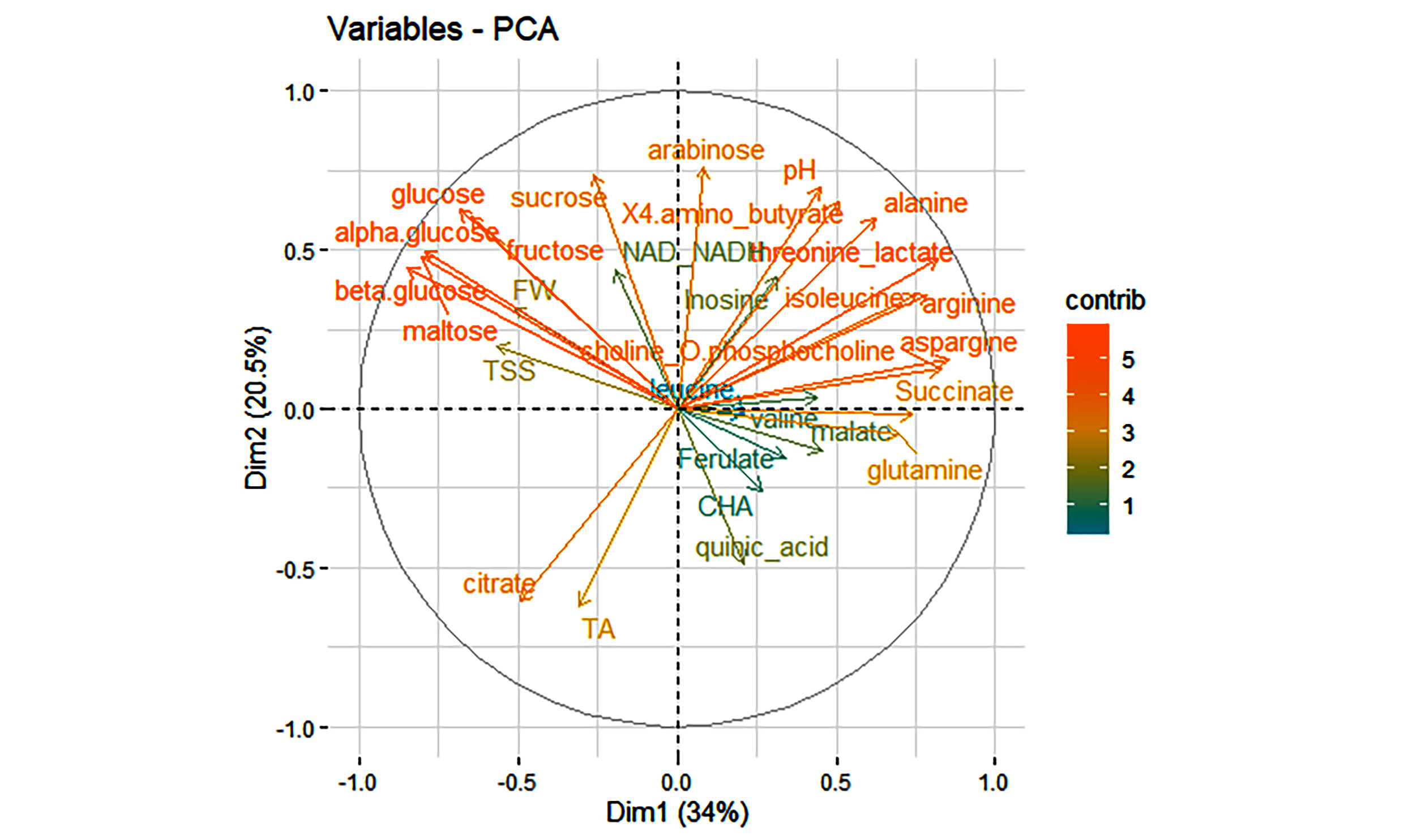Blueberries have seen a rapid increase in consumer demand and production over the past 15 years. The North American blueberry industry and consumers are more selective of their fruit choice, with an increased focus on quality. Multiple studies in blueberry over the last decade reported that fruit quality (FQ) traits influence consumer preferences.

As fruit quality traits play a significant role in consumer preferences, understanding what controls these qualities within the berry is important. Some cultivars already meet consumer preferences, but FQ traits vary greatly between them. The blueberries consumers pick up in grocery stores are a mix of multiple cultivars, often leading to an inconsistent eating experience for consumers and impacting future consumption.
Developing new cultivars that meet consumer preferences is critical for sustaining the growth of the blueberry market. For years, blueberry breeding has relied on phenotypic-based selection. But this process is pricey, can take anywhere from 10–20 years, and is somewhat inefficient, leaving breeders only able to select for a limited number of traits. With so much need to improve FQ traits, techniques like DNA or genomic-assisted breeding will be a necessity for the future of the industry in order to meeting consumer FQ preferences at a faster pace. Understanding the genetics that influences these traits is the first step to further develop DNA-assisted breeding.
The most common method to study the genetic mechanism and genes that control a phenotype like FQ traits, is called quantitative trait loci (QTL) mapping. Through this analysis, DNA markers representing the region of the genome are associated with a given phenotype and are named QTL. Due to limited availability of resources—like high-density linkage maps—needed for this type of study in blueberry, only a few QTL studies for FQ traits have been performed. VacCAP is working to close these gaps and to gain a better understating of these economically important traits’ genetics, in order to improve future cultivars for consumer preferences.
The objectives of this study were to construct a high-density linkage map and to identify the underlying genetic basis of FQ traits in blueberry. The study also investigated the association between FQ traits and organic acids, sugars, and amino acids.
A total of 287 F1 individuals derived from a cross between two southern highbush blueberry cultivars, ‘Reveille’ and ‘Arlen’, were phenotyped over three years (2016–2018) for FQ traits. These traits include:
- size (FW)
- total soluble solid content (TSS), correlated with fruit sweetness
- titratable acidity (TA), correlated with fruit acidity
In addition, the study evaluated the correlation between FQ traits and the chemical composition of blueberry fruits in particular organic acids and sugars, which contribute to TA and TSS, respectively.
High Density Linkage Map Construction
High-density genetic maps are necessary for genetic/QTL mapping studies, and are useful for genomic–assisted breeding—providing critical information about the organization of the genome of the population being evaluated. Yet, due to high costs and limited tools, only two linkage maps are currently available for tetraploid blueberry.
The linkage map constructed here integrated 17,438 DNA markers, that represent the largest set of markers (17,438) and F1 individuals (287) in blueberry. Also, the map covered all 96 parental homologous chromosomes.
Genetics of Fruit Quality Traits and Association with Chemical Composition
Eighteen QTLs loci for FW, TA, TSS and pH were identified, with ten of them detected in more than one year. A total of 25 metabolites peaks including seven sugars, five organic acids, and nine amino acids were detected and used for correlation analysis.
Citric acid and quinic acid were the most abundant organic acids in blueberry, respectively. Beta glucose followed by fructose were the most abundant sugars. Arabinose and maltose were the least abundant sugars in blueberry. The data also showed that arabinose is an important discriminant variable in the sugar group. Among the annotated amino acids, arginine and 4-amino butyrate were the most abundant. Isoleucine and asparagine were the least abundant amino acids observed in blueberry.
Highlights of the QTL mapping and correlation analysis for each trait are summarized below.
Total Soluble Solid Content (TSS)
- Seven QTLs were identified
- Six of those QTLs, three mapped on chromosome 7 and three mapped on chromosome 10, were detected across three years
- QTLs explained phenotypic variance ranging from 7 to 28%
- Sugars molecules showed a positive correlation with TSS.
Titratable Acidity (TA)
- Seven QTLs were identified
- Six of those QTLs, three mapped on chromosome 3 and three mapped on chromosome 5, were detected across three years
- QTLs explained phenotypic variance ranging from 7 to 28%
- Organic acids, citric acid, and quinic acid were significantly and positively correlated with TA
- Citrate is an important variable to discriminate the genotypes and strongly associated with TA
pH
- Ten QTLs were identified
- Three of those QTLs, mapped on chromosome 3, were detected across three years and co-localized with that of TA
- QTLs explained phenotypic variance ranging from 8 to 13%
Fruit Size (FW)
- Thirteen QTLs were identified
- Three of those QTLs, mapped on chromosome 4, were detected across three years
- QTLs did not explain more than 10% of the phenotypic variance
Overall, stable QTLs—those detected across three years—were noted for all FQ traits. This indicates that the genetic regions underlying these QTLs affect the traits independently of the year or environment. Stable QTLs are the best candidates to design DNA assisted-breeding strategy.
The results also indicated that the QTLs for TA and pH mapped on chromosome 3 likely represent the same genetic locus and are explained by the accumulation of organic acids, in particular citric acid.
Why Are These Traits Important?
Consumers indicated flavor and sweetness as positive blueberry traits, with TSS as the most and TA as the least important characteristics associated with overall consumer preferences.
The balance between sugars and acids is a determinant factor for taste. For example, sweet berries don’t inherently have high sugar content, but simply lower level of acids, resulting in a higher the sugar/organic acid ratio.
In this study, strong correlation was observed between TA and pH, which are excellent predictors of blueberry sourness—a negative trait for consumers. The higher the acidity, the less they prefer the fruit. However, they did not show strong and consistent correlation with FW and TSS over the years, suggesting that the relationship between these traits was strongly environmentally dependent, which aligns with previous studies.
FW is an important as consumers prefer larger berries. This study highlighted that larger-sized berries have higher sugar concentrations than smaller-sized berries. This suggests selection for larger fruit could lead to selection for high sugar content and TSS—associated with sweetness, a positive consumer trait. However, FW was negatively correlated with multiple acids, and both phenotypic and genetic analysis suggests the trait is a complex genotype by environmental factors.
The Future of Blueberry Breeding
This study provides critical, first insight into the genetic inheritance of multiple, key FQ traits, developed a high-density linkage map with highest number of markers and individuals, and established the first assessment of the relationship between fruit quality traits and metabolites (sugars, organic acids, and amino acids).
The development of blueberry varieties that consistently meet consumer preferences is a high priority for the industry. Informed by the observations in this study, breeders can design a strategy to optimize their breeding programs, selecting for QTLs that meet the right balance between increase TSS and reduce TA, to bring the best cultivars to consumers. Complementary studies on FQ traits associated to consumer preference—including FW, TSS, TA and pH—are ongoing as part of the VacCAP project.













